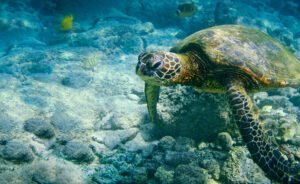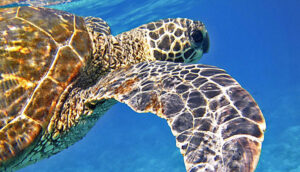Sea turtles, these majestic creatures of the ocean, evoke a sense of wonder with their grace and resilience in the vast waters they call home. Amidst the fascination surrounding these marine giants, questions arise about their anatomy and unique features.
One such inquiry often posed is: ‘Do sea turtles have tails?‘ Exploring the intricacies of these remarkable beings reveals not just their physical attributes but also unveils the marvels of nature beneath the waves.
Importance of understanding sea turtles anatomy

Understanding the anatomy of sea turtles is crucial for various reasons, especially for those involved in conservation, research, and education.
Here are some key reasons why understanding sea turtle anatomy is important:
- Conservation Efforts:
-
- Rescue and Rehabilitation: Understanding the anatomy helps in providing better care for injured or stranded turtles. Knowledge of their internal and external structures aids veterinarians and rehabilitators in diagnosing and treating health issues.
- Protection of Nesting Sites: Knowledge about sea turtle anatomy can inform conservationists about the specific needs and vulnerabilities of these animals, allowing for better protection of nesting sites and habitats.
- Research and Science:
-
- Biological Studies: Studying the anatomy of sea turtles provides valuable insights into their biology, physiology, and behavior. This knowledge contributes to a better understanding of their life cycles, reproductive strategies, and overall ecology.
- Disease Understanding: Understanding the anatomy is essential for identifying and studying diseases that affect sea turtles. This knowledge is crucial for managing and mitigating health threats to these populations.
- Education and Outreach:
-
- Public Awareness: Teaching the public about sea turtle anatomy helps raise awareness about the importance of conservation. This understanding can lead to increased public support for protective measures and conservation initiatives.
- Training Professionals: Educating researchers, conservationists, and wildlife professionals about sea turtle anatomy is essential for building expertise in the field. This knowledge enhances their ability to conduct effective research and conservation programs.
- Policy and Management:
-
- Regulatory Measures: Understanding the anatomy of sea turtles can influence the development of regulations and policies aimed at protecting these species. Knowledge about their biology and behavior informs decisions related to fishing practices, coastal development, and pollution control.
- Population Management: Detailed knowledge of sea turtle anatomy is essential for managing and conserving different populations. This includes considerations for genetic diversity, population dynamics, and habitat requirements.
- Climate Change and Adaptation:
-
- Understanding Adaptation: Sea turtles are vulnerable to climate change, including rising temperatures and changing ocean currents. Knowledge of their anatomy is crucial for understanding how these animals may adapt or be impacted by such environmental changes.
Do sea turtles have tails?
Yes, sea turtles do have tails. The tail of a sea turtle is also known as a “cloaca.” Unlike some land turtles, sea turtles have a cloaca, which is a single opening used for excretion and reproduction. The cloaca is located on the underside of the turtle, near the base of the tail.
It’s important to note that the tails of sea turtles are relatively short compared to some other types of turtles. Additionally, the presence of a tail and the structure of the cloaca can vary slightly among different species of sea turtles.
Also, sea turtles use their tails for various functions related to reproduction, such as mating and laying eggs. Overall, while sea turtles do have tails, the size and specific characteristics can vary between species.
Tail Adaptations in Sea Turtles

Sea turtles have various adaptations in their tails that are well-suited for their aquatic lifestyle. These adaptations are crucial for their survival in the marine environment.
Here are some key features of sea turtle tails:
- Streamlined Shape:
-
- Sea turtle tails are long and streamlined, helping to reduce drag as the turtle swims through the water. This streamlined shape is essential for efficient and swift movement.
- Muscular Tail:
-
- The tail of a sea turtle is muscular and powerful. The muscles enable them to generate strong and rapid movements, aiding in swimming, diving, and navigating through ocean currents.
- Paddle-like Structure:
-
- The tail serves as a paddle, helping sea turtles propel themselves through the water. The flattened and elongated structure of the tail is particularly useful for efficient swimming.
- Dorsal Fin Adaptation:
-
- Some sea turtle species, such as the loggerhead turtle, have a distinctive dorsal keel on their tail. This keel resembles a saw-like structure and provides additional stability and efficiency in swimming.
- Temperature Regulation:
-
- In addition to aiding in locomotion, the tail also plays a role in temperature regulation. Sea turtles are known for their ability to regulate their internal body temperature to some extent. The tail, being a relatively exposed and thin part of their body, can help dissipate excess heat.
- Reproductive Functions:
-
- In females, the tail plays a crucial role during the nesting process. Female sea turtles use their hind flippers (which are part of the tail) to dig nests in the sand where they lay their eggs. The tail’s strength and mobility are essential for this digging process.
- Sexual Dimorphism:
-
- In some species, the tail may exhibit sexual dimorphism, meaning there are differences between males and females. For instance, male sea turtles may have longer and thicker tails compared to females, and these differences may be related to reproductive roles.
You all should know that different species of sea turtles may have slightly different tail adaptations based on their specific ecological roles and habitats. These adaptations collectively contribute to the sea turtle’s ability to navigate the ocean, forage for food, and carry out essential reproductive activities.
Different Sea Turtle Species and Their Tails
While sea turtles do not have tails in the same way that some animals do, they have distinctive features that can be considered analogous to tails.
Let’s explore some of the main sea turtle species and their unique characteristics:
- Loggerhead Turtle (Caretta caretta):
-
- Tail Analog: Loggerhead turtles have a relatively short tail compared to other species. It is more noticeable in males and is used during mating.
- Physical Characteristics: They have a large head and powerful jaw muscles, which they use for crushing hard-shelled prey like crustaceans.
- Green Turtle (Chelonia mydas):
-
- Tail Analog: Green turtles have a short tail, and it can be challenging to distinguish between males and females based on external characteristics.
- Physical Characteristics: They are named for the greenish color of their fat, not their shells. Green turtles are herbivores and primarily eat seagrasses and algae.
- Hawksbill Turtle (Eretmochelys imbricata):
-
- Tail Analog: Like other sea turtles, hawksbills have a short tail. However, it’s not easily visible.
- Physical Characteristics: Hawksbills have a distinctive beak that looks like a hawk’s beak. They are known for their beautifully patterned shells, which are often used to make jewelry.
- Kemp’s Ridley Turtle (Lepidochelys kempii):
-
- Tail Analog: Kemp’s ridley turtles have a relatively short tail, and it may not be as visible as in some other species.
- Physical Characteristics: This is the smallest species of sea turtle. They are primarily found in the Gulf of Mexico and are known for mass nesting events known as arribadas.
- Leatherback Turtle (Dermochelys coriacea):
-
- Tail Analog: Leatherbacks have a short tail, but it is not as prominent as in some other species.
- Physical Characteristics: Leatherbacks are unique among sea turtles because they lack a hard shell. Instead, their shell is leathery, giving them their name. They are also the largest sea turtle species.
- Olive Ridley Turtle (Lepidochelys olivacea):
-
- Tail Analog: Similar to other species, the tail of the olive ridley turtle is relatively short.
- Physical Characteristics: They are known for their olive-green coloration. Like Kemp’s ridley turtles, olive ridleys are known for arribadas, where large numbers of females come ashore to nest simultaneously.
- Flatback Turtle (Natator depressus):
-
- Tail Analog: The flatback turtle has a short tail, but it is not as easily visible as in some other species.
- Physical Characteristics: The flatback is named for its relatively flat shell. It is primarily found in the waters around Australia.
These descriptions provide a brief overview of the sea turtle species and their general characteristics. While they all have tails, they are not as pronounced as those in some other animals. The tails of sea turtles are used during mating, and differences between male and female tails can be subtle.
Environmental Factors Affecting Sea Turtle Tails

The tails of sea turtles, or more accurately, their reproductive anatomy, can be influenced by various environmental factors. These factors can affect the sex ratio of hatchlings and play a crucial role in the survival and population dynamics of sea turtle species.
One of the most interesting phenomena related to sea turtle tails is temperature-dependent sex determination (TSD).
Here’s how environmental factors, particularly temperature, can affect sea turtle tails:
- Temperature-Dependent Sex Determination (TSD):
-
- Overview: The sex of sea turtle hatchlings is not determined by genetics but rather by the temperature at which the eggs incubate. This phenomenon is known as TSD.
- Specifics: In most sea turtle species, warmer temperatures during incubation tend to produce female hatchlings, while cooler temperatures result in males. The pivotal temperature, at which an equal number of males and females are produced, varies among species.
- Sand Temperature During Nesting:
-
- Influence: The temperature at which the eggs are incubated is determined by the temperature of the sand where the nest is located.
- Implications: Changes in the temperature of nesting beaches, whether due to climate change or local factors, can impact the sex ratio of hatchlings. Warmer temperatures may lead to a higher proportion of female hatchlings.
- Climate Change:
-
- Rising Temperatures: Global climate change can lead to an increase in average temperatures, affecting the nesting environment of sea turtles.
- Sex Ratio Skew: If temperatures continue to rise, there is concern that more female sea turtles will be produced, potentially skewing the sex ratio and affecting the reproductive capacity of populations.
- Beach Erosion and Nesting Habitat Loss:
-
- Impact: Changes in beach structure, erosion, or habitat loss due to human activities can affect the thermal properties of nesting areas.
- Consequences: Altered nesting environments may expose eggs to more variable temperatures or lead to the relocation of nests, influencing the sex ratio and survival rates of hatchlings.
- Human Influence on Nesting Sites:
-
- Artificial Lighting: Coastal development with excessive artificial lighting can disorient hatchlings, leading them away from the sea. This can impact their survival and the overall population.
- Beach Nourishment: Changes in the composition of beach sand, such as through nourishment projects, can influence temperature and impact the success of nests.
- Pollution and Contamination:
-
- Chemical Exposure: Pollution, including plastics and chemical contaminants, can have detrimental effects on sea turtle nesting sites.
- Indirect Effects: Pollutants may indirectly influence the health and reproductive success of sea turtles, potentially affecting the development of their tails.
Understanding and addressing these environmental factors is crucial for the conservation of sea turtles. Conservation efforts often involve monitoring nesting sites, protecting critical habitats, and implementing strategies to mitigate the impacts of climate change and human activities on these remarkable creatures.
Conclusion
If you are on the search for the answers to the question do sea turtles have tails, then you can get all that you need on this page. Sea turtles do not have tails in the traditional sense, but they possess reproductive anatomy that can be considered analogous to tails.
The length and visibility of these structures can vary among species, with males typically exhibiting more noticeable features.
Furthermore, environmental factors, particularly temperature during incubation, play a pivotal role in determining the sex of sea turtle hatchlings, adding an intriguing dimension to the reproductive biology of these ancient marine reptiles.

